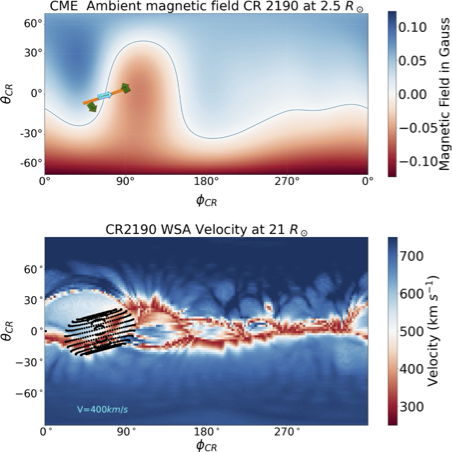Unveiling CME Dynamics: Rare Rotations of CMEs in the Heliosphere
| Nugget | |
|---|---|
| Number: | 484 |
| 1st Author: | Sandeep KUMAR |
| 2nd Author: | Nandita SRIVASTAVA |
| Published: | 30 December 2024 |
| Next Nugget: | CME evolution |
| Previous Nugget: | Spatial and Spectral Evolution of Microwave and X-Ray Sources During the Limb Flare SOL2023-02-05 |
Introduction
Coronal mass ejections (CMEs) are magnetized plasmas with high kinetic and magnetic energies in the heliosphere. They originate in the low corona and can have appreciable space weather effects at the Earth. This Nugget aims at understanding the trajectory of a CME through the heliosphere, where interaction with the existing plasma (the solar wind) can affect the nature of the impact at Earth.
Influence of the Solar Wind Medium on CME Propagation
CMEs will sometimes deflect non-radially due to their interaction with the ambient solar wind. Apart from the deflection, CMEs are also reported to undergo rotation in the corona and heliosphere. Although CME rotation is commonly observed in the lower corona, where the ambient magnetic field dominates, the reported cases of CME rotation in the heliosphere are very few in the literature.
We carried out a study (Ref. [1]) on the heliospheric propagation of 15 CMEs by continuously tracking them in the heliosphere using a software tool to define their 3D geometry, up to 80 R☉ in the field of view of the Heliospheric Imager on the Solar Orbiter. About half of these events followed self-similar expansion up to 40 solar radii. The remaining events showed deflection either in latitude, longitude or a tilt change. We also investigated the ambient solar wind and magnetic field medium for these CMEs. Our analysis shows that two CMEs were deflected in latitude predominantly in the equatorward direction, toward the heliospheric current sheet due to magnetic field interaction. We also found that faster CMEs with speeds greater than 850 km/s, which initially propagated away from the Sun-Earth line in a westward direction, were deflected toward the east, i.e., toward the Sun-Earth line, because of the interaction with the slower solar wind ahead of them.
Only two events showed significant rotation in the heliosphere, 23-24 May 2017 (described in Ref. [1]) and 5 October 2012 CME (described in Ref. [3]) . We used toroidal and cylindrical flux-rope fitting (Ref. [2]) on the in situ observations of interplanetary magnetic field and solar wind parameters to estimate the tilt at Lagrangian point L1 for these two events.
We estimated a 19° rotation in the tilt of the CME observed on 23-24 May 2017 (Figure 1). A comparison with the tilt of the flux rope estimated at L1 suggested that the CME did not rotate further beyond 70 R☉. An investigation of the ambient magnetic field environment of the CME (Fig 1 top panel) showed that the Lorentz force favoured the rotation of this CME. The speed of this CME was slow, comparable with the ambient solar wind speed which was homogeneous (Figure 1 bottom panel) leading to negligible interaction due to solar-wind drag. Therefore, further rotation in the heliosphere was not observed which is also confirmed by the low value of tilt of the flux rope estimated at L1.
This is in contrast to the results for the 5 October 2012 CME, where a continuous rotation of the CME from 44° at around 15 R☉, approximately 65° at 58 R☉, and 110°at L1 was reported in our previous work, as shown in Figure 2 (Ref. [3]). This continuous rotation in the heliosphere is attributed to both the Lorentz force and the non-homogeneous solar wind environment ahead of the CME (Figures 2 and 5 of Ref. [3]).


Our study reveals that CME rotation is a rare phenomenon observable in the Heliospheric Imager. Although CME rotation is a well-observed phenomenon in the lower corona where the ambient magnetic field dominates, our analysis shows that conducive conditions of both the magnetic field and the solar wind are required to favor a persistent rotation of the CME throughout the heliosphere. This is possible in the cases only where we are able to capture the total change in the orientation of the CME (i.e., tilt) by tracking them in the heliosphere over a larger distance.
Conclusion
The ambient solar wind plays a very crucial role in the CME propagation in the heliosphere. Although CME deflection cases are common, CME rotation is hard to observe in the heliosphere. This is because of two main reasons: firstly, rotation of CMEs in the heliosphere requires favorable conditions of both the magnetic field and the solar wind as shown. Secondly, the fact that CME becomes fainter and incoherent as it reaches the HI1 field of view makes it challenging to analyze the CME as a global structure. Our study underscores the importance of observations of the Heliospheric Imager (HI1) onboard STEREO, which provide the connection between near-sun observations and in situ measurements at the L1 point. The results of our study have significant implications for our understanding of how CMEs move through the heliosphere and their space weather impact.
Acknowledgements
Co-authors Nat Gopalswamy, Ashutosh Dash, Dinesha V. Hegde, Nikolai V. Pogorelov and Seiji Yashiro, are acknowledged for Refs. [1] & [3].
References
[1] "On the Influence of the Solar Wind on the Propagation of Earth-impacting Coronal Mass Ejections"
[3] "Rotation of a Stealth CME on 2012 October 5 Observed in the Inner Heliosphere"